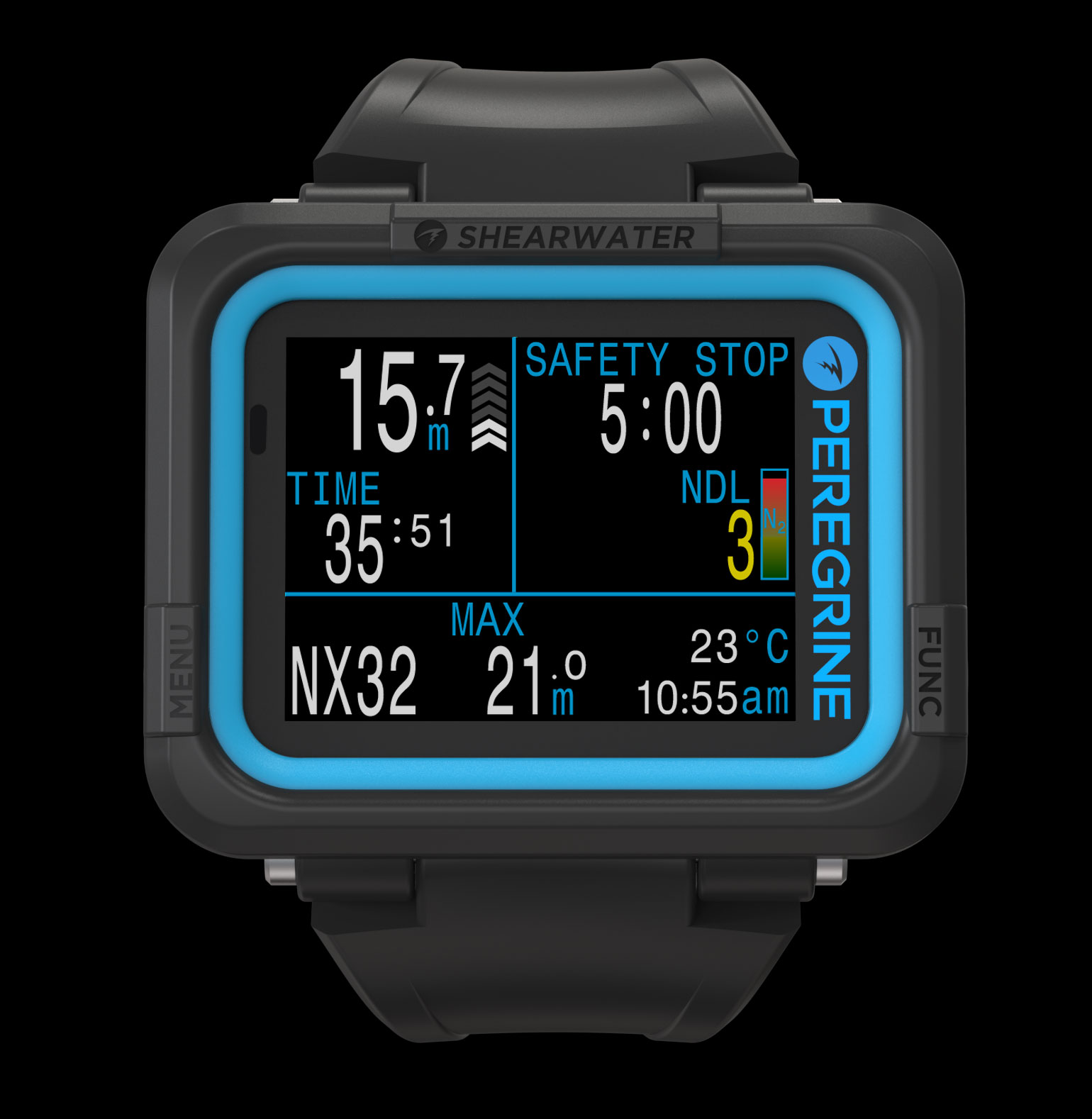
SHEARWATER PEREGRINE REVIEW
by: Vinnie
Date: August 2020
Before I start, I should make it clear I am a big fan of Shearwater diver computers – in my experience, the Perdix and Teric are the best dive computers in the market today, and I believe this strongly enough to have purchased a Perdix AI for myself at full retail from a store in Singapore.
A full review of the Perdix is coming soon, but here is what sets it apart: customizable algorithm, full features (trimix, Open Circuit, Closed Circuit), built-in compass, air integration, ability to handle more gas mixes than you are ever likely to use, user changeable battery, upgradable firmware and a fantastic, legible display, all in a sturdy housing that is designed for extreme use (this is certainly no dainty wrist jewellery). There is literally NOTHING you are missing in this dive computer.
Unfortunately, all this comes at a price – the Perdix (and its sibling, the Teric) are not cheap. While there is definitely something to be said for having a computer that is virtually future-proof and that you are not likely to outgrow, the price of the higher end Shearwater does tend to put off people looking for a more value-priced computer. Enter the Shearwater Peregrine – with an MRP of Rs 36,000 (at the time of writing this article) it is an “entry level” dive computer intended to bring the Shearwater experience within reach to more people.
Let’s see how it fares!
UNBOXING
I like the minimalist packaging that the computer comes in – it comes packaged in its own travel case, and inside, you find the following:
- A 26mm rubber strap and a set of bungee cords
- Locking bars and tools for attaching them
- Wireless charger
- USB cable
- An inspection certificate
- A couple of stickers
- A spare screen protector
Everything that you need – and no huge amount of wasted plastics and paper. Kudos to Shearwater for a very eco-friendly packing job.
Note that while my unit came with a black strap and a black bungee cord, you can get white or a matching blue rubber strap for the Shearwater Peregrine, if you so desire, as pictured below:
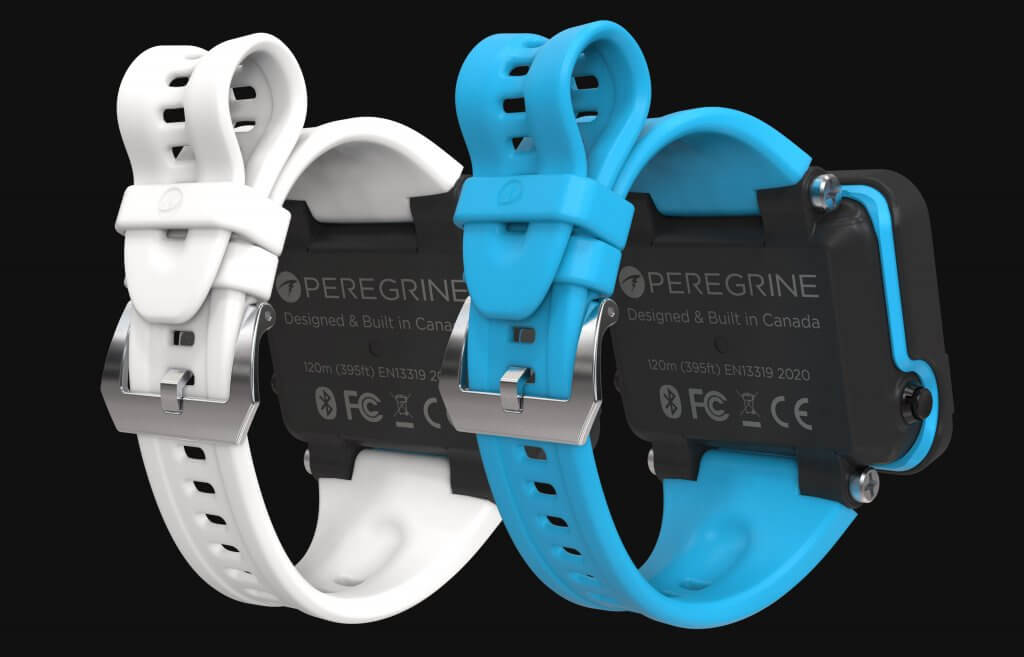 Colored straps are available for the Peregrine – never under-estimate the importance of color in making sure you stand out amidst a sea (pun intended) of divers all dressed in black!
Colored straps are available for the Peregrine – never under-estimate the importance of color in making sure you stand out amidst a sea (pun intended) of divers all dressed in black!
FORM FACTOR, DISPLAY & ERGONOMICS
The Shearwater Peregrine is an over-sized dive computer – not a wrist-watch sized dive computer. As you can see below, the screen is approximately the same size as the Perdix, but the casing has been slimmed down a significant degree. The Perdix has a very strong “all business” look to it – this is a computer that is all business, all the time. The lines of the Peregrine are a little more relaxed, with a pop of color in the form of the blue bezel around the screen (although that is the only color available at present).
 The Shearwater siblings – the Perdix on the left, the Peregrine on the right. The 158 day surface interval on my Perdix is a sad testimony to the effects of the COVID pandemic!
The Shearwater siblings – the Perdix on the left, the Peregrine on the right. The 158 day surface interval on my Perdix is a sad testimony to the effects of the COVID pandemic!
Generally, all else being equal, I have a preference for wrist-watch sized computers: they are easier to travel with, you are less likely to forget them in your hotel room on the morning of the dive, you don’t have to take them off before/after the dive while putting on your wetsuit (and so risk them getting damaged or even falling off the side of the boat!).
So why have I gone from a Suunto D9Tx, a watch-sized dive computer, to a Perdix, an oversized unit? The key phrase is “all else being equal”. In some cases, a larger dive watch is just an exercise in cost-cutting – miniaturization is expensive, after all. In other cases, the larger form factors gets you more – better battery life, higher quality display, better presentation of information, etc. I am happy to say that the Peregrine, like its bigger brother, does utilize this large form factor very well.
Take a look at this:
 Peregrine Display (image borrowed from the Shearwater website, as I sadly have not been able to get into the water with my unit)
Peregrine Display (image borrowed from the Shearwater website, as I sadly have not been able to get into the water with my unit)
A few things jump about this display. To start with, the legibility and ease of reading the info. This is a modern display with a high degree of contrast and easily legible in all conditions. Second, note the use of colors to highlight important information (eg, NDL reaching ‘0’ in this case). And last and most importantly, notice how well the screen of computer displays information in an easy to read format. As an added bonus, you can even change the font colors as per your preferences.
One of the most common issues I have seen with divers is while they may be familiar with the “regular” screen of their computer, they often cannot read the decompression screen that comes up if they exceed their NDLs – ie, the very information for which they bought the dive computer. Shearwater’s experience with the needs of tech divers is clearly obvious here – in this example. the decompression information is clearly presented and cannot be confused with anything else.
It bears repeating – it doesn’t matter how high-tech your dive computer is: if it isn’t intuitive to understand, especially in a stressful situation, it is not a good option. The Peregrine is aces in this regard, and for these tangible improvement, I am willing to forego the convenience of a watch-sized form factor (same as the Perdix).
In terms of ergonomics, the Peregrine, like the Perdix, uses a 2 button interface. I initially expected this to be fairly clunky, given my experience with other 2-button dive computers, but the interface is surprisingly intuitive. It helps that Shearwater uses the display to give you very clear indications of what each button press is supposed to do.
 The labels at the bottom of the screen tell you very clearly what each button press does – in this case, pressing the left button takes you to the next setting, while pressing the right button goes into planning mode. The logic is fairly intuitive and easy to pick up after a couple of uses. Note the green color display – you can change font colors as well.
The labels at the bottom of the screen tell you very clearly what each button press does – in this case, pressing the left button takes you to the next setting, while pressing the right button goes into planning mode. The logic is fairly intuitive and easy to pick up after a couple of uses. Note the green color display – you can change font colors as well.
About the only downsize of this interface is that if you accidentally overshoot a setting, you have to scroll through the settings to get back to it. But the buttons are have a great tactile feel (the ones on the Peregrine are actually a lot nicer than the ones on my Perdix) and it takes all of 5-6 seconds to do this, so it isn’t really a great loss.
FEATURES AND FUNCTIONS
While the Shearwater Peregrine dive computer is an “entry level” model, it is certainly not lacking in features. Here is a short list of the essential features and functions.
For starters, as you might expect from something carrying the Shearwater name, it is a full-featured computer designed for decompression diving. Unlike many of the entry-level dive computers designed for recreational diving which often tend to penalize divers significantly if they go into decompression, the Shearwater Peregrine will work well if you decide to get into extended range or technical diving. And of course, even if you accidentally go into decompression on a recreational dive, it will give you accurate information on how to handle your decompression safely.
Unlike its bigger brothers, the Perdix and Teric, the Peregrine does not offer trimix or closed circuit capabilities. However, the Peregrine dive computers also offers a 3-gas Nitrox mode. This lets you use 3 different nitrox mixes: typically a bottom gas and 2 different decompression mixes for accelerated deco. This makes it suitable for all air/nitrox based technical diving.
And of course, for recreational diving, the Peregrine has the standard modes: Air, Nitrox and Gauge (no freediving mode but you would not wear a large dive computer like this for freediving anyway). You have the option of setting both high and low PPO2 alarms, as well as depth and time alarms. One cool feature: you also get a vibration mode, in case you are diving with a thick hood and unable to hear audible alarms. Pretty neat!
The computer is based on the Buhlmann ZHL-16C: the industry-standard algorithm, proven and refined over decades to offer the safest possible approach to decompression today. As is typical for most dive computers, you get 3 different conservatism settings – Low, Medium and High. Even at its lowest setting, the Peregrine is not excessively liberal – so this actually is a setting that may work for a lot of divers, depending on their preferences (see my article on How to Pick a Dive Computer for a more in-depth discussion on conservatism).
However, what sets the Peregrine apart is the ability to customize the GFLow / GFHigh percentages, if you so desire – this is a fantastic feature and is absolutely amazing to find it in this price range.
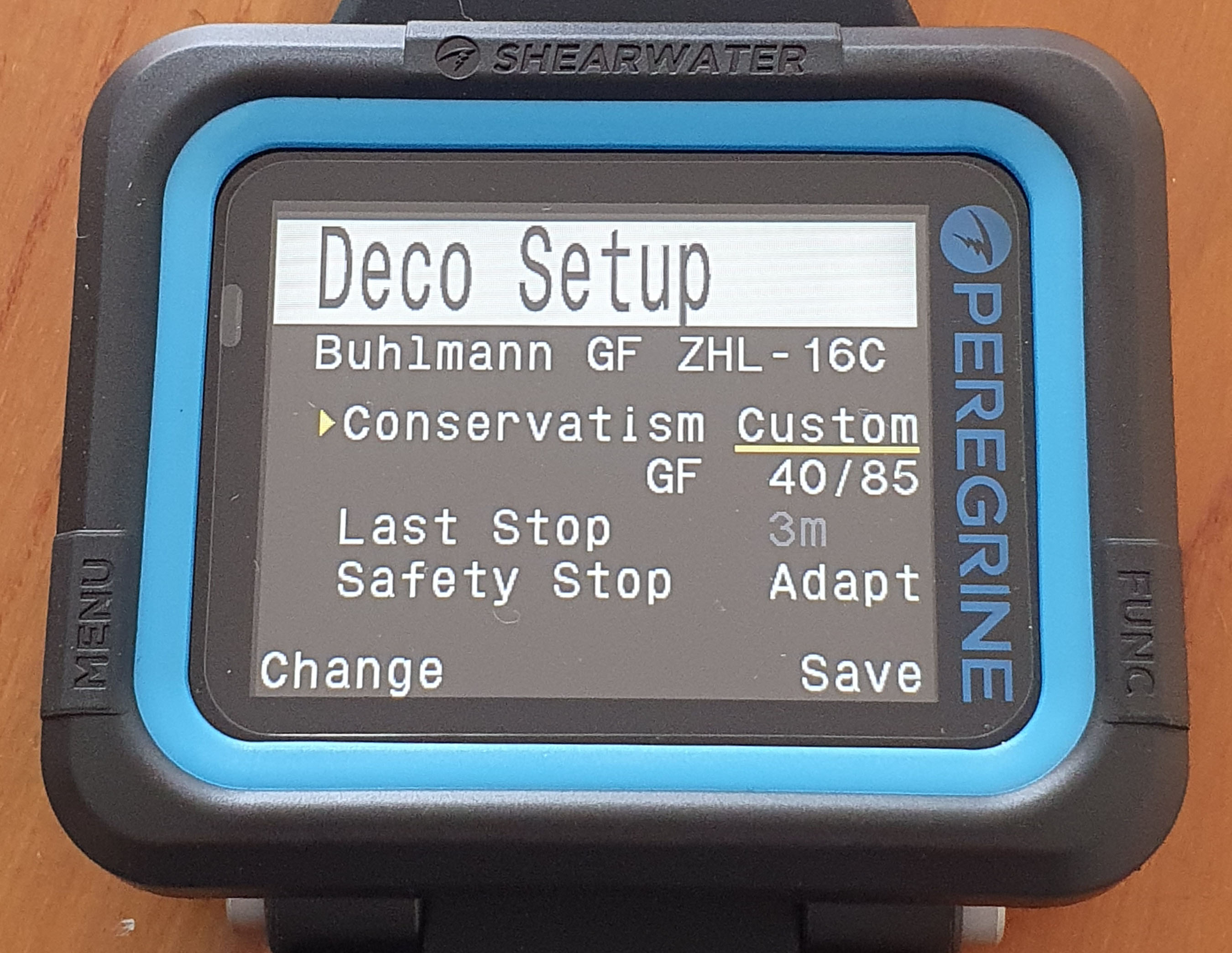 Ability to adjust the conservatism setting on the Shearwater Peregrine
Ability to adjust the conservatism setting on the Shearwater Peregrine
Do note that this feature is for experienced divers with an in-depth knowledge of decompression theory as well as their own personal risk tolerances – so I will advise not messing with it unless you are very sure you know what it does (hint: if you have to ask someone what settings to use here, you are not ready to use it. When you are ready to use this feature, you will know how to set it, and you will be thankful you have had this feature).
In addition, the Peregrine also checks off my other vital criteria – a battery that is either rechargeable or user-replaceable. Unlike the Perdix, which uses a user-replaceable AA battery, the Peregrine offers wireless charging – place it on the provided USB mat and it charges. The mat is slightly smaller than the dive computer, so easy enough to pack and carry on a trip. For what it is worth, the Peregrine also seems to charge off the wireless charger I use for my mobile phone.
The Peregrine also has Bluetooth connectivity with Shearwater’s desktop or phone (Android/iOS) app, which lets you upload your dive logs to Shearwater’s cloud-based server and view them on the app.
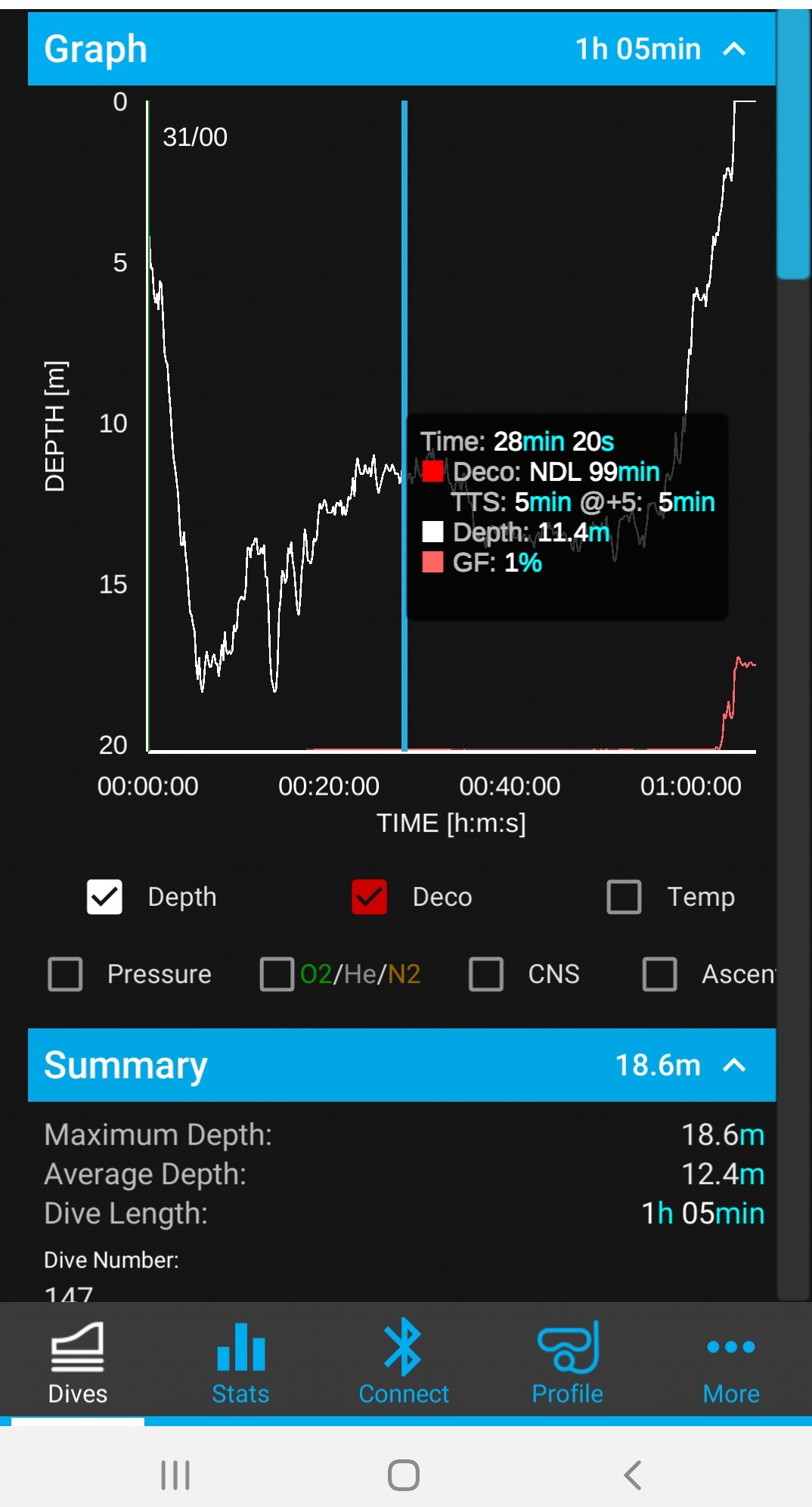 Displaying the dives on the Shearwater app
Displaying the dives on the Shearwater app
The dive log on the Shearwater app shows you your profile as well as tissue loading at any time. This log is from a Perdix, but the Peregrine information is very similar.
The app also allows you to upgrade your computer’s firmware.
Unlike the Perdix, the Peregrine does not offer a digital compass or air integration. While neither of these features are essential, they are certainly nice to have. However, to be fair, the computers offering these features are all one entire price tier above the Peregrine in price as well (typicall Rs 10,000 – Rs 15,000 more expensive).
USAGE
While I didnt have a chance to take the Shearwater Peregrine dive computer into the ocean for a dive, I did do a little freediving with it to see how it behaved. Also, a lot of my experience with the Perdix translates over directly to the Peregrine as well – after all, both these operate on more or less the same platform.
From an algorithm point of view, there is nothing to say about the ZHL-16C – as mentioned earlier, it is the gold standard of decompression algorithms. So what remains is ease of use, along with features. And “ease of use” has always been a strong point of Shearwaters, given their origins in tech diving.
Setting up a computer before the dive is very easy – it is a few buttons to adjust the nitrox and once you do, the nitrox percentage is clearly visible on your display. As with most computers these day, the Peregrine turns on automatically once you descend to about 1m of water. And as discussed earlier, the display is super legible and easy to read.
 Picture courtesy Shearwater
Picture courtesy Shearwater
The Shearwater display breaks up into 3 panels. The upper left panel shows you the dive depth and time. The upper right panel shows you decompression information (critically, the no-deco info and deco info are displayed in different locations, to prevent you from confusing the 2 numbers). And the smart use of color coding highlights important information – eg, that you are running low on NDL in the photo above.
The bottom panel can be customized as per your preferences. On my unit, I have replaced the time and temperature with average depth, which is useful for me to estimate my air consumption and overall nitrogen loading (just because my computer is doing that for me doesn’t mean I switch my brain off!).
You can also get a visual display of your tissue loading, for each of the 16 compartments in the Buhlmann model – while this is typically not the most actionable of information, I find it a very useful learning tool to correlate nitrogen loading from actual diving to the theory of decompression. Seeing how the graph changes over the course of a diving vacation, or even after a shallow dive vs a deep dive can be very instructive.
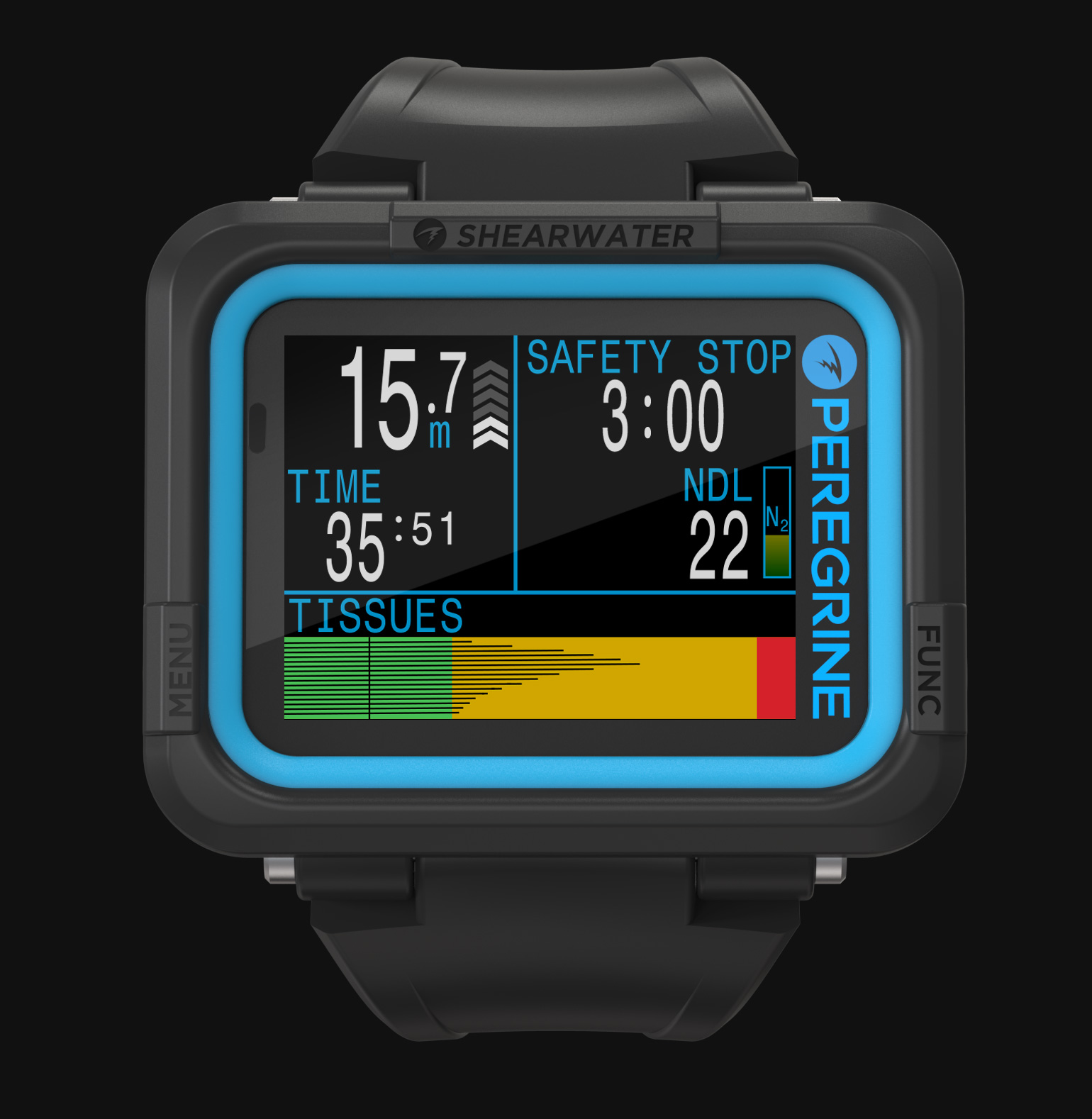 Tissue loading as a visual graph – as always, color coded to make it easy to understand
Tissue loading as a visual graph – as always, color coded to make it easy to understand
The Shearwater also has a very easy to use dive planning mode – you can choose to plan your dive as if it were about to start immediately or after some time (eg, if you still had some more surface interval to complete), and figure out your NDLs accordingly.
 Use the screen on the left to set when the dive is starting (now or later) and then, on the subsequent screen, you can see your NDLs
Use the screen on the left to set when the dive is starting (now or later) and then, on the subsequent screen, you can see your NDLs
And as mentioned, the solid, easy to press buttons make the entire experience of navigating the Shearwater Peregrine dive computer an absolute pleasure (users of the Suunto Zoop, for example, will know and appreciate what I mean!). Having used and reviewed a LOT of dive equipment, I cannot describe how happy I get when I see manufacturers getting ergonomics and usability right – these are things that you appreciate every single minute of use, and mean far, far more to me than a laundry list of features which are a nightmare to actually use.
Lastly, battery life is rated up to 30 hours, give or take, depending on screen brightness. I haven’t had a chance to test this but after a few days of playing around with the dive computer quite thoroughly, including some water sessions, the battery indicators still reads full. So I expect it to be more or less as per spec- this means you can easily get one dive trip out of it, without needing to faff around with charging the unit every day or two.
SUMMARY AND CONCLUSIONS
So how does the Shearwater fare against the competition and is it worth buying?
At a price of Rs 36,000 (at the time of writing this article), the Peregrine is more expensive than the Aqualung i200 and the Mares Smart, both of which have an MRP of around Rs 27,000.
However, while it may be marketed as an “entry level” computer by Shearwater, that is only when compared to Shearwater’s offerings. As computers go, the Peregrine is far more advanced than typical entry level computers – it may not have all the bells and whistles of its bigger brothers, but when it comes to basic decompression horsepower, it stomps over everything else: decompression, 3 gas tech open circuit, customizable deco profile, a fantastic color display – these are all features you typically find on computers costing well over Rs 60,000.
As you gain skills and expand the scope of your diving, it is possible for you to outgrow the entry-level computers fairly quickly. However, the Peregrine’s advanced deco capabilities means that it will stay with you for everything short of rebreathers or trimix. Personally, this is a tradeoff I would be very happy to make: while the absolute entry-level computers do get the job done, the Shearwater is a big step up in terms of ease of use and also scalability, in terms of growing with you as a diver.
That said, there are a couple of features that it is missing – air integration and digital compass. These are both nice-to-have features for sure and given a choice, I would have preferred a dive computer which had these options. But keep in mind that all dive computers with these options cost a lot more (Rs 45,000 and higher, and that excludes the cost of the air transmitter) – and those computers also lack the same functionality when it comes to core decompression features.
So as far as tradeoffs go – compared to the next pricing level, you are gaining a far more advanced computer and saving a significant chunk of money but by giving up on a couple of nice-to-have but non-essential attributes. Is that a fair trade-off? It really depends on your personal preferences.
Ideally, I would rather pay more and not to make a trade-off at all. But if I had to, I’d pick the Shearwater options. The way I look at it: I can always get a small compass and clip it to the side of the computer’s strap or to my BCD, if need be (and while it may be important to me, I also realize a compass isn’t something most recreational divers use a lot). And while I really like air integration and would dearly love to have it if given a choice, I would pick a customizable algorithm and ability to handle multiple gas mixes over it: one is “nice to have”, the other actually impacts my diving in a meaningful way. And then there is the matter of the price difference too – skipping these extraneous features saves you a lot of money.
What the Peregrine lacks in bells and whistles, it makes up by in core functionality that no one else offers for anywhere close to this price: you are getting most of the core functionality of the Perdix, for only a modest premium over an entry-level computer.
Very highly recommended – and definitely makes our “Recommended Gear” list!
DIVEIndia is an authorized distributor for all Shearwater products, including the Peregrine, and you can use the link above to purchase your own unit.
Do note, however, that our reviews are not affected by the fact that we sell the item – rather, we only sell the items that we like. We sell Mares, Aqualung, Tusa, Scubapro, Shearwater and more – between them, there are enough quality dive products that we have absolutely no need to push gear that isn’t up to the mark. The stuff we recommend is the stuff that we believe in ourselves.


